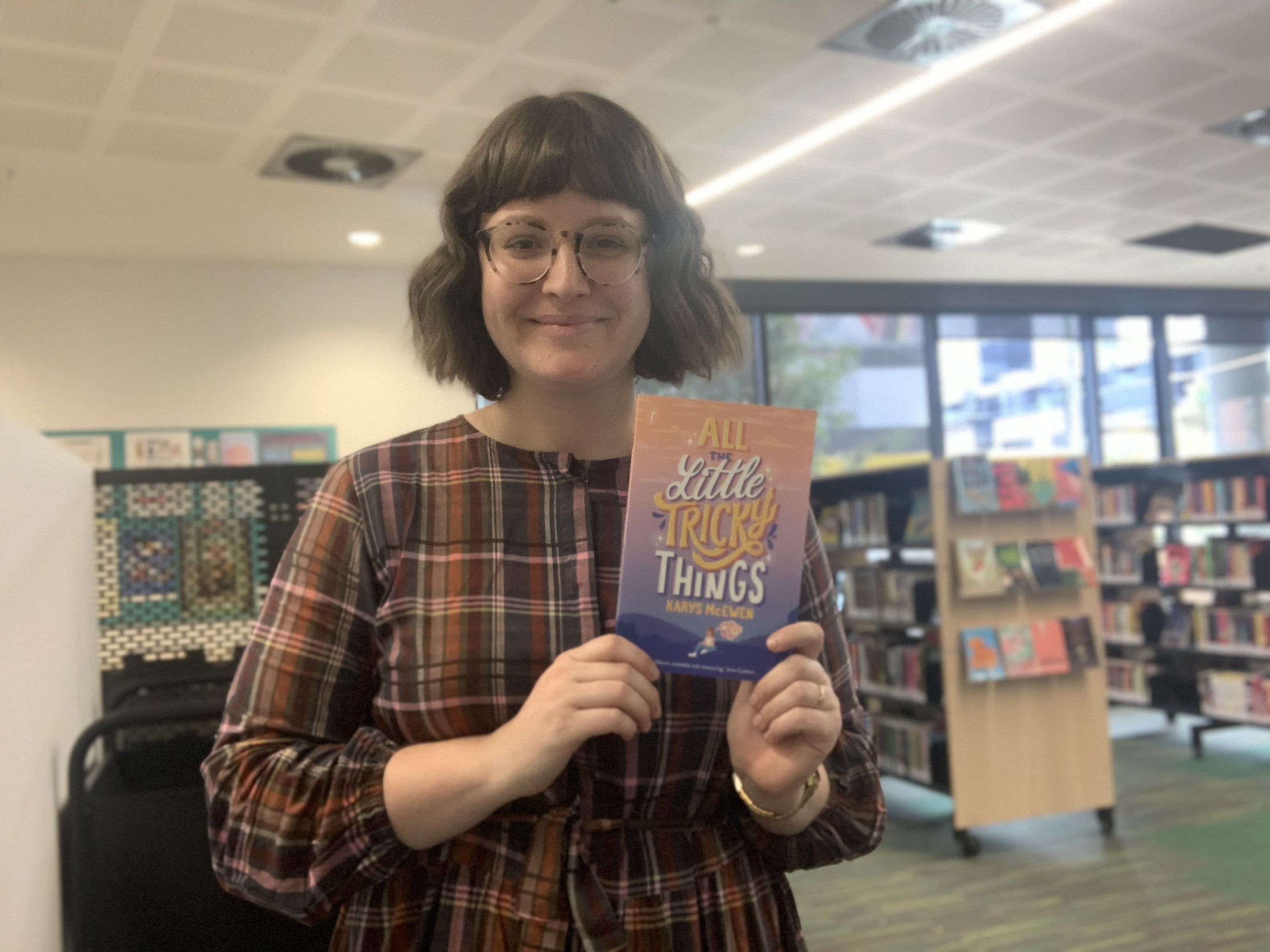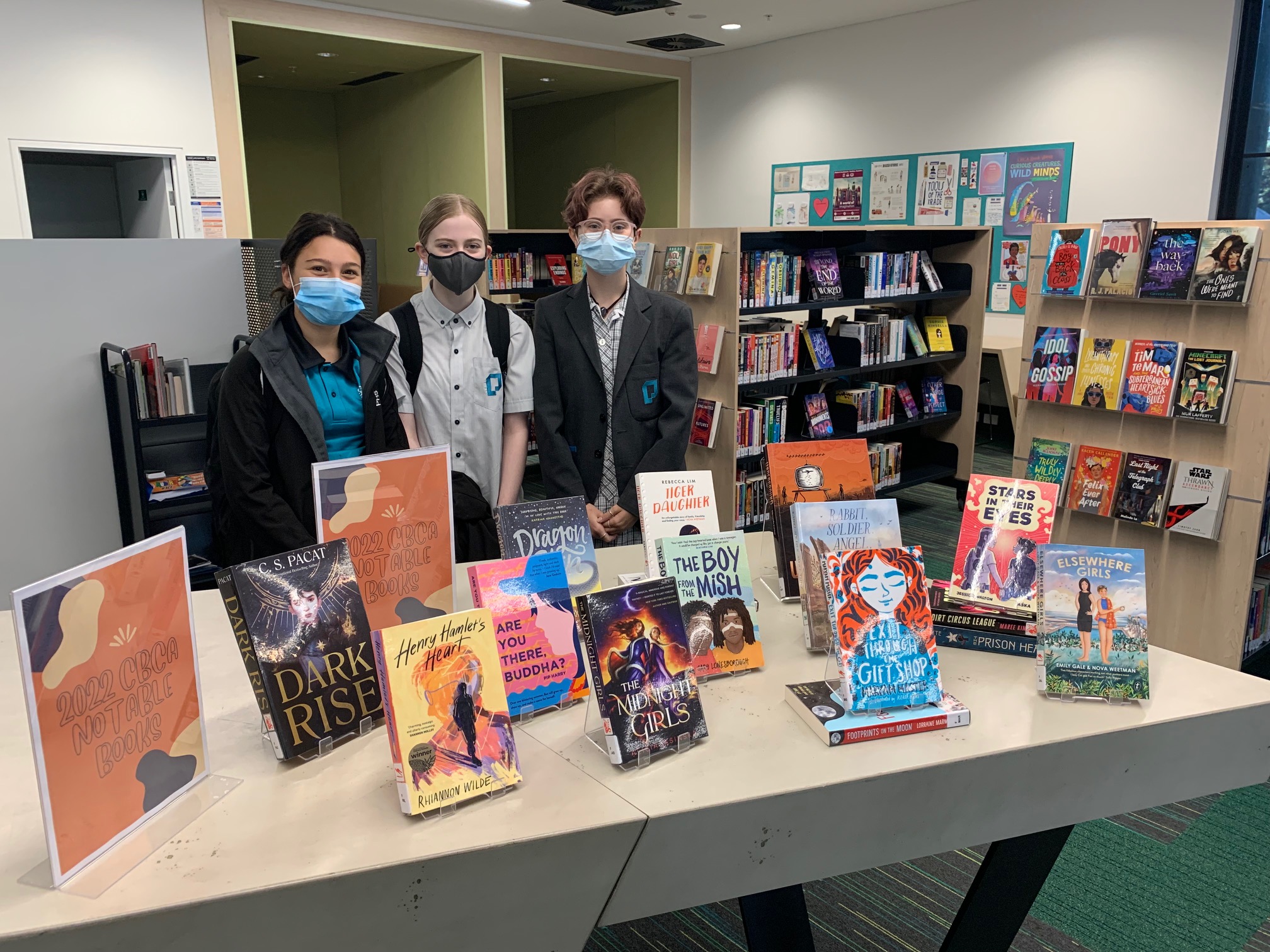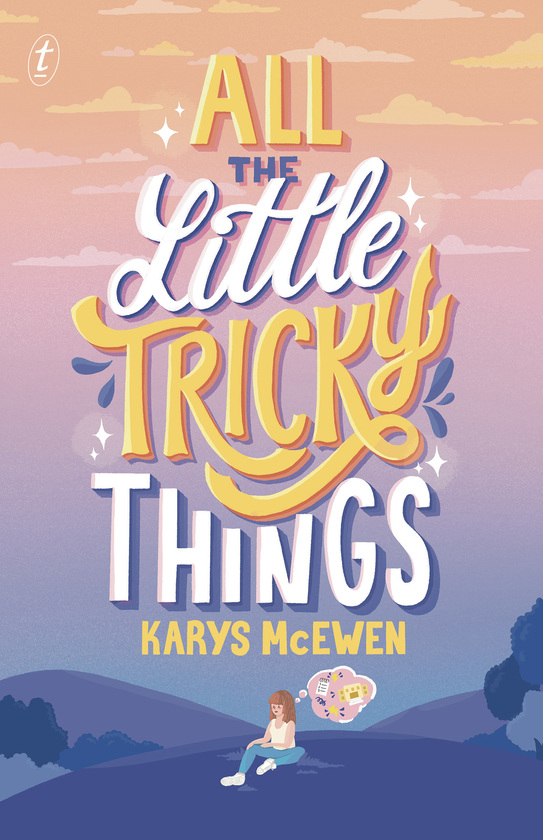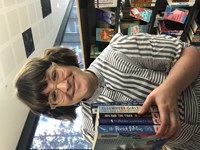Issue 121
Term 2 2022
Two sides of children’s literature: gatekeeper and creator
Karys McEwen on drawing from her experience as a school librarian when writing her first novel, 'All the little tricky things'.

Karys holding her first book, 'All the little tricky things'
Drawing from the experiences of young people
The idea for my middle-grade debut novel, All the little tricky things, published by Text Publishing in May this year, came from a conversation with two Year 7 students.
I have been a high school librarian for over eight years and throughout that time I have formed close relationships with the kids that come into my library. Sometimes I wonder if it’s the nature of a library that allows students to be more open. I pride myself on it being a place where students feel safe.
During our chat, the two students began reflecting on starting high school. They were the first cohort at a brand new school, so their experiences were heightened by the focus being squarely on them. They told me starting high school had been terrifying, even without older kids to intimidate them. I asked them what their biggest worries were. ‘This is going to sound ridiculous,’ one of them said, ‘but I was so nervous that I wouldn’t remember where the toilets were.’ We all giggled. The other student mentioned the stress of figuring out how to open their locker and they both said they weren’t sure if they would make any friends on the first day. They admitted that, in hindsight, they were embarrassed at how scared they were, because everything worked out in the end, just like everyone said it would.
These concerns, which they could laugh about a few months later, are real for many young people, no matter how trivial they may seem. Moving from primary school to high school heralds a time of transition in students' lives, and with this comes all kinds of changes – friendships, their bodies, the relationship with their parents, and all the glorious messiness that comes with deciding exactly who you are and forging your own path in the world. I’ve seen it happen for years in the schools where I work, and had similar experiences myself as a teenager. I decided to write that story: a quiet novel about a time where everything is changing, and a young person who is trying to make sense of it all.
From school librarian to children’s author
For years I have been one of the so-called ‘gatekeepers’ of children’s literature, in both my work with the Children’s Book Council of Australia and as a high school librarian. This is not a responsibility that I take lightly. I also choose to see my influence on students as a positive thing, rather than something that could be restricting or damaging. School librarians are often the ones who introduce young people to literature, especially if reading isn’t necessarily valued at home. Librarians have the power to put the right books into the right hands at the right time.
School library staff undertake their role in different ways; we all have our tried and tested methods for readers’ advisory. One of my favourite activities to run with a class is a Genre Round Robin, where students each spend time at different library tables that are set up with books in an array of genres. Students read blurbs and first pages, and as they go along, they make notes about the books they have tried and which ones they’d consider borrowing. School librarians can also benefit from sharing our tricks with our colleagues in other schools. My friend Erin Wamala at Genazzano FCJ College recently posted on her Instagram account (@mswbooklady) a book tasting activity she ran with her classes. Her students were given time to explore several books in depth and write responses to determine if they were ‘just right’ for them, and why or why not.

Students at Karys’ school library.
While group activities like these are valuable, the most success I’ve had is with one-on-one readers’ advisory. All young people have something to gain from working individually with a children’s literature expert who understands what will be right for them, or has the time to figure it out. At Prahran High School, our English classes from Year 7–10 are held in the library at least once a fortnight. This gives me the chance to work with students and find the perfect book for each of them. I spend time getting to know the kids and match them with something based on their ability and interests, whether that’s a particular genre, a past read, something new to challenge them, or something they want to learn about.
You always get one kid who says they hate reading. This isn’t something to dismiss or be put off by; it’s better to see it as a challenge. I often try to match these students with books based on what they’re watching on Netflix or their hobbies. Sometimes they just want something short and easy, and that’s fine! I’ll give them an engaging graphic novel or even a magazine to hook them in. I always preface every recommendation by saying ‘I won’t be offended if you don’t like this – just let me know and we’ll find you something else.’ I also usually give students two or three books when helping them choose something, so they have a few options and aren’t at risk of getting discouraged if the first one doesn’t work. Something else that should always be considered is peer recommendations. As hard as I work, sometimes a kid is more likely to trust their classmate’s or friend’s suggestion, and that is perfectly acceptable. If a student asks for a fantasy recommendation and I know there’s a kid in the class who is a voracious fantasy reader, I’ll pair them up to let the former lead the latter in finding the perfect book, and just stay out of their way.

What kids want from the books they read
Having spent nearly a decade matching young readers with books, I felt the pressure to get my novel right, especially the voice of my tween narrator, Bertie, and expressing what life is like for young people today. Kids are shrewd when deciding what to read. They don’t like to be talked down to, they can smell writing that feels disingenuous a mile away, and they need to be hooked into a story almost immediately. They all judge a book by its cover, even if you’re not supposed to. I recommend books to students nearly every day and see this fussiness firsthand; I always try to embrace it. Not every book is right for every reader and kids should be entitled to take control of what they choose to read. Let’s all encourage them to make their own decisions, and be on the sidelines ready to help when they need.
Putting a book out into the world as a writer can be terrifying, maybe even more so when you know how discerning young readers are. I have tried to write a story that is authentic to my own experiences as a tween, as well as drawing on what I see unfold in the schools where I have worked. These are my two hopes: that I have done justice to the experiences of the students who originally sparked the idea for All the little tricky things, and that my book will be ‘just right’ for at least some of the kids who discover it in their own school libraries, or have it handed to them by their passionate, intuitive school librarians.
